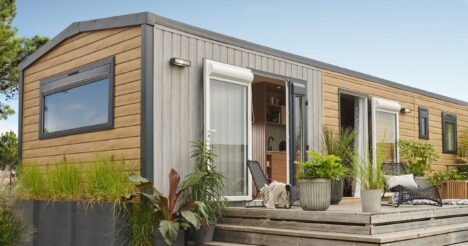Far Infrared and Mobile Living

Far infrared heating is revolutionising off-grid and mobile living. From narrowboats to campervans, caravans to static homes, this blog will be diving into the unique advantages of far infrared heating in compact, energy-conscious spaces.
We’ll explain how this technology delivers gentle, efficient warmth without drying the air or taking up precious room—making it ideal for life on the move or in small-scale homes.
Power Requirements
Far infrared heaters have no moving or serviceable parts and emit heat radiation, so they are very energy efficient. Many people are scared by the term ‘radiation’, but in this case, it simply refers to the heat projected out the front of the panel.
Our surface-mounted panels can convert power into heat radiation that directly heats objects/surfaces (thermal masses) upon contact, meaning that typically less energy is lost as wastage when compared to other electric heaters.
For example, a 900W far infrared panel can comfortably heat a room that would require a 2kW – 3kW fan heater.
Mobile homes, especially camper vans, will benefit from the power saving the most because panels directly heats surfaces, so the occupant only needs warming; the rooms are smaller, meaning less watts are needed on average per room; and there are fewer rooms meaning fewer heaters overall.
Space-Saving Capabilities
Heating panels are very thin: our Platinum range is 20mm thick, and typically sits roughly 20mm away from the wall, therefore a surface-mounted panel would only reach a rough total of 4cm into the room.
When choosing an appropriate panel, you can opt for a ceiling-mounted panel or a wall-mounted panel based on the application and both options have their own advantages.
Ceiling panels, for instance, are even more discreet than wall panels and provide a better spread of heat when multiple heaters are used.
Wall panels, however, are the simpler range to install and there are higher wattages available.
Overall, panels are the ultimate space-saving solution for mobile homes as they take up virtually no space when installed and they’ll stay out the way after installation.
Dry, Comfortable Heat
As established earlier, far infrared heats objects and people – not the air.
This type of direct heat reduces condensation and damp and promotes a healthier indoor environment by drastically reducing the risk of mould, it even has numerous proven health benefits like:
- Improved blood circulation
- Arthritis relief
- Pain relief
- Skin health
- Better sleep
The nature of far infrared heat makes it fitting for mobile living, especially on a narrowboat because the rectangular panels can be dotted along the ceiling/walls to heat each room while simultaneously fighting against damp and the build-up of mould from being on the water.
Installation and Maintenance
The main difference between ceiling and wall-mounted panels is the installation process. Wall panels simply need to be hung on the wall and plugged in while ceiling panels need the appropriate brackets to be mounted on the ceiling beforehand.
Once the panel has been installed, the brackets can be completely forgotten about as there are no serviceable parts. The lack of fans and moving parts is the reason why far infrared panels operate without making any sound and explains why they don’t need maintenance.
Static homes can benefit from this especially, because the best method of heating is to have a heater in every room and blower heaters would need maintenance every so often on every heater in every room.
Removing any kind of maintenance removes the inconvenience of regular checks and is a testament of their reliability.
Similarly, infrared panels are typically made with materials like aluminium, carbon crystal or tempered glass and all these are relatively light materials. As thin as they are, far infrared panels are very lightweight even though they can be much bigger than a typical electric heater.
With far infrared panels being so lightweight, there is always the option to use them as freestanding units. If there is no available wall or ceiling space, you can still stand the heater up in the room (using an appropriate panel stand.)
Freestanding units are a good option for camper vans because they don’t have any fragile moving parts and they can resist vibrations, with the help of the panel stand, which is a very important feature when used on a moving vehicle.
Conclusion
Whether on the road, water or grass, far infrared panels can keep you warm and cosy while fighting off mould and damp despite taking up almost no space at all. Far infrared heating offers a uniquely effective, energy-efficient, and space-saving solution for mobile homes. Its ability to deliver comfortable, dry heat while consuming minimal power makes it perfectly suited to limited space and off-grid living. With silent operation, zero maintenance, and flexible installation options, far infrared heating not only enhances comfort but also promotes a healthier and more sustainable way of living on the move. For anyone looking to upgrade their mobile home heating system, far infrared is a smart, modern choice that combines performance with practicality.


